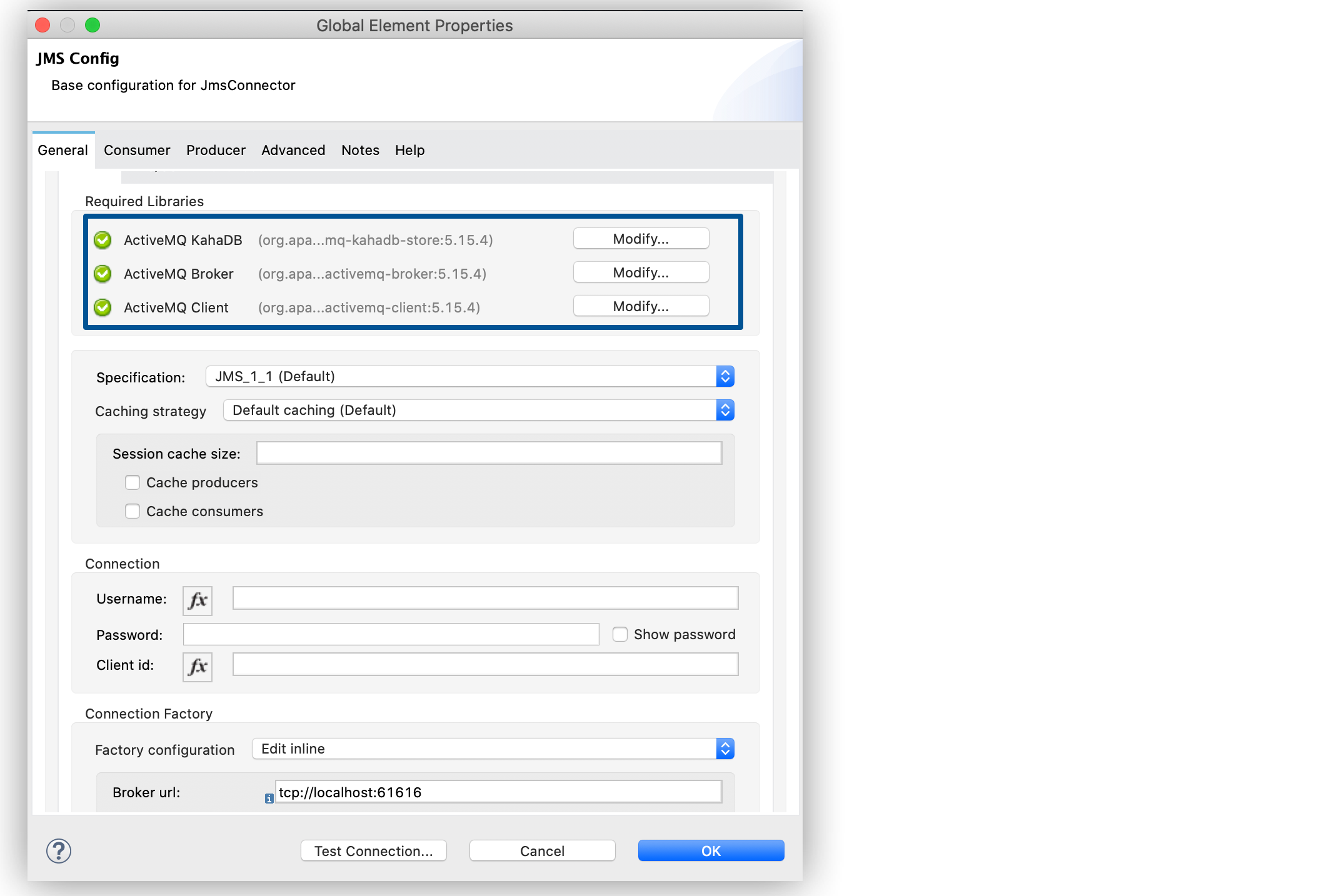
Configure an ActiveMQ Connection for JMS Connector
Anypoint Connector for JMS (JMS Connector) includes an ActiveMQ connection configuration, which provides support for ActiveMQ 5. Using this connection, you can set JMS 1.1 (default), JMS 1.0.2b, or JMS 2.0 specifications, and you can configure not only all of the general connection parameters for JMS but also the custom parameters that are present only in ActiveMQ.
Configure an ActiveMQ Connection
After you declare the ActiveMQ connection, customize Connection Factory to your desired configuration. Every parameter in the connection comes with a default value, meaning that you are required to configure only the parameters relevant for your use case. Also, the ActiveMQ connection exposes parameters that are exclusive to the ActiveMQ implementation, like Initial redelivery delay.
In the following example, you configure an ActiveMQ Connection:
-
In Studio, navigate to the Global Elements tab.
-
Click Create.
-
In the filter box type
jmsand select JMS Config. -
Click OK.
-
In the Connection field select ActiveMQ Connection.
-
In the Factory configuration field, select Edit Inline.
-
Set the Broker url field value to the address of the broker to connect to, for example,
tcp://localhost:61616. -
Click OK.

In the XML editor, the <jms:active-mq-connection> and <jms:factory-configuration> configuration looks like this:
<jms:config name="JMS_Config">
<jms:active-mq-connection >
<jms:factory-configuration brokerUrl="tcp://localhost:61616" />
</jms:active-mq-connection>
</jms:config>Configure an ActiveMQ - No Connectivity Test Connection (DEPRECATED)
There may be certain scenarios in which more than one node cannot use the credentials of a broker connection simultaneously. In these cases, Mule applications use the Primary node only field set to true to ensure listener execution on only one of the nodes. However, the connection test that is performed prior to deployment can result in a deployment error on the primary node if another node already used the credentials. For this particular case, use ActiveMQ Connection - No Connectivity Test, which is identical to the ActiveMQ Connection, except that it does not perform a connectivity test prior to deployment.
In the following example, you configure an ActiveMQ Connection - No Connectivity Test:
-
In Studio, navigate to the Global Elements tab.
-
Click Create.
-
In the filter box, type
jmsand select JMS Config. -
Click OK.
-
In the Connection field, select ActiveMQ Connection - No Connectivity Test.
-
Set the optional Client id field.
-
In the Factory configuration field, select Edit Inline.
-
Set the Broker url field value to the address of the broker to connect to, for example,
tcp://localhost:61616. -
Click OK.
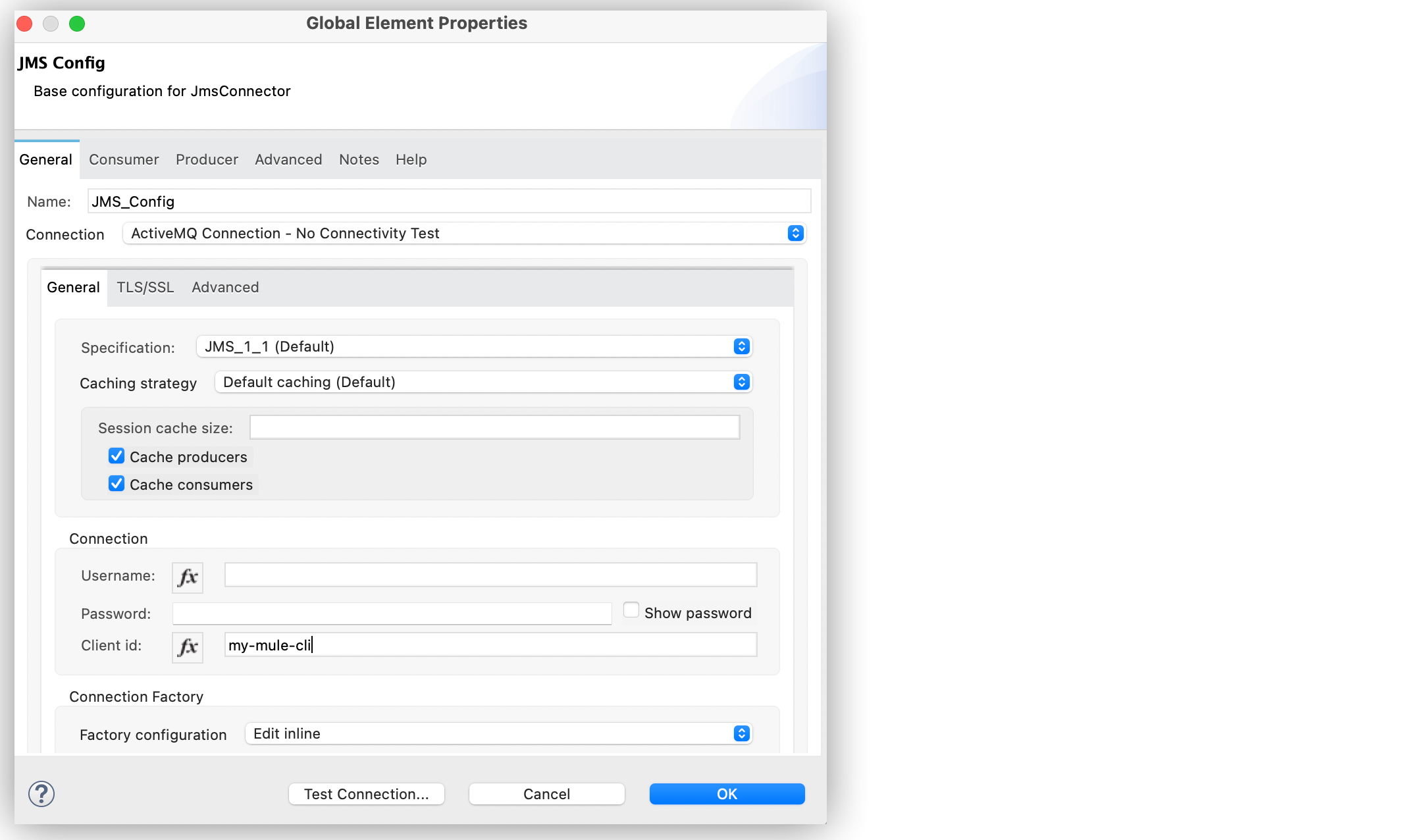
In the XML editor, the <jms:active-mq-nct-connection> and <jms:factory-configuration> configuration looks like this:
<jms:config name="JMS_Config">
<jms:active-mq-nct-connection clientId="my-mule-cli">
<jms:factory-configuration brokerUrl="tcp://localhost:61616" />
</jms:active-mq-nct-connection>
</jms:config>Configure the Required Libraries
When you configure any connection type, you must always configure a library containing the JMS client implementation, because JMS Connector is not bound to any particular implementation. Configure ActiveMQ external libraries in the global elements view of Studio or manually add the library dependency in your pom.xml file.
-
ActiveMQ KahaDB
Theactivemq-kahadb-storedependency is required only when using an persistent in-memory broker based on the VM transport (such asvm://localhost?broker.persistent=true). This dependency provides a validorg.apache.activemq.store.kahadb.KahaDBPersistenceAdapterimplementation. This dependency is also required for persistent message delivery.In your
pom.xmlfile in Studio, adding the dependency looks like this:<dependency> <groupId>org.apache.activemq</groupId> <artifactId>activemq-kahadb-store</artifactId> <version>5.14.4</version> </dependency> -
ActiveMQ Broker
Theactivemq-brokerdependency is required only when using an in-memory broker based on the VM transport (which is the one configured by default). This dependency provides a validorg.apache.activemq.broker.Brokerimplementation.In your
pom.xmlfile in Studio, adding the dependency looks like this:<dependency> <groupId>org.apache.activemq</groupId> <artifactId>activemq-broker</artifactId> <version>5.14.4</version> </dependency> -
ActiveMQ Client
Theactivemq-clientdependency is always required to use ActiveMQ connections. Choose one that provides a validorg.apache.activemq.ActiveMQConnectionFactoryimplementation.
In your pom.xml file in Studio, adding the dependency looks like this:
+
<dependency>
<groupId>org.apache.activemq</groupId>
<artifactId>activemq-client</artifactId>
<version>5.14.4</version>
</dependency>To configure these libraries in the Global Element view, follow these steps:
-
In Studio, navigate to the Global Elements tab.
-
Click Create.
-
In the filter box, type
jmsand select JMS Config. -
Click OK.
-
In the Connection field, select ActiveMQ Connection.
-
In the Required Libraries section that shows the ActiveMQ KahaDB, ActiveMQ Broker and ActiveMQ Client libraries, click the Configure… button to install the dependency.
-
Select any of the following install options:
-
Add recommended library Installs the recommended library.
-
Use local file Browse to a local file for the required engine library and install it.
-
Add Maven dependency Browse to the dependency and install it.
-

Configure the In-Memory Broker
By default, Anypoint Connector for ActiveMQ (ActiveMQ Connector) uses an in-memory broker, which makes it easy to start building an application without configuring a connection against an external broker. The in-memory broker is required to configure both the ActiveMQ KahaDB and ActiveMQ Broker libraries. The default URL is:
vm://localhost?broker.persistent=false&broker.useJmx=false
To configure the in-memory broker in Studio, follow these steps:
-
In Studio, open the JMS Config global element window.
-
In the Connection Factory section, set the Factory configuration field to Edit inline.
-
Set the Broker url field to the address of the broker to connect, for example,
vm://localhost?broker.persistent=false&broker.useJmx=false. -
Click OK.

In the XML editor, the brokerUrl configuration looks like this:
<jms:config name="JMS_Config" doc:name="JMS Config">
<jms:active-mq-connection >
<jms:factory-configuration brokerUrl="vm://localhost?broker.persistent=false&broker.useJmx=false"/>
</jms:active-mq-connection>
</jms:config>Configure Message Redelivery
When a message cannot be processed correctly, it’s not acknowledged. The message is then redelivered and probably again not processed correctly, which causes the cycle to execute indefinitely.
To prevent a message from endless redelivery, configure the Max redelivery field.
By default, JMS Connector uses a maximum redelivery value of 0, which means that messages won’t be redelivered, regardless of whether the message is recovered or rolled back from a transaction. If the message has persistent delivery set, ActiveMQ sends the message to a DLQ.QUEUE (a dead letter queue).
ActiveMQ also enables you to configure a client-side redelivery.
-
The Initial redelivery delay field enables you to configure, in milliseconds, how much time to wait before the first message redelivers.
-
The Redelivery delay field enables you to configure, in milliseconds, how much time to wait until the message is subsequently redelivered after the first redelivery.
To configure these fields in Studio, follow these steps:
-
In Studio, open the JMS Config global element window.
-
In the Connection Factory section, set the Factory configuration field to Edit inline.
-
Set the Initial redelivery delay field to
1000. -
Set the Redelivery delay field to
100. -
Set the Max redelivery field to
10. -
Click OK.
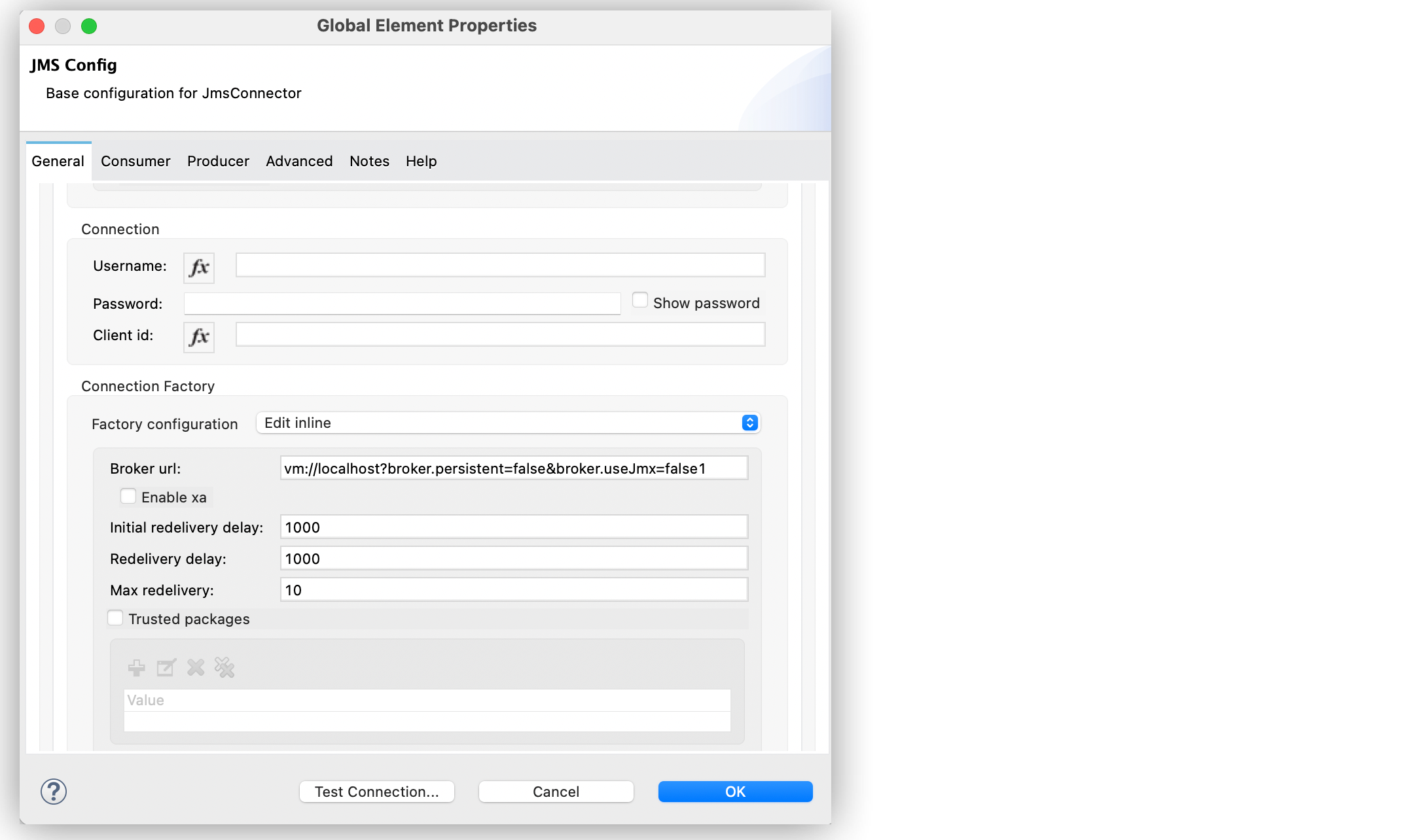
In the XML editor, the maxRedelivery,redeliveryDelay, and initialRedeliveryDelay configurations look like this:
<jms:config name="JMS_Config">
<jms:active-mq-connection>
<jms:factory-configuration maxRedelivery="10"
redeliveryDelay="100"
initialRedeliveryDelay="1000"/>
</jms:active-mq-connection>
</jms:config>Configure Trusted Packages
ActiveMQ versions 5.12.2, 5.13.0, and later restrict the classes that can be serialized and deserialized, helping to prevent the execution of a malicious payload on the host system.
For ActiveMQ, JMS Connector enables by default only the JDK and JRE provided classes, so if you
need to exchange object messages, you must add the packages your applications use by activating the Trusted packages field.
Even though you can also enable the Trust all packages field to allow the serialization of more classes by allowing any object to be serialized and deserialized, this is not as secure as leaving it disabled in most cases. Keep this parameter disabled to improve the security and help prevent malicious attacks.
In the following example, you configure the connection to enable only users who are compliant with the com.mulesoft.someapp and com.mulesoft.someapp.model packages to consume and produce ObjectMessages:
-
In Studio, open the JMS Config global element window.
-
In the Connection Factory section, set the Factory configuration field to Edit inline.
-
Select the Trusted packages field.
-
Click the plus sign to add a new package.
-
In the Trusted package window, set the Value field to
com.mulesoft.someapp. -
Click Finish.
-
Repeat Step 4.
-
In the Trusted package window, set the Value field to
com.mulesoft.someapp.model. -
Click Finish.
-
Select the Trust all packages field.
-
Click OK.
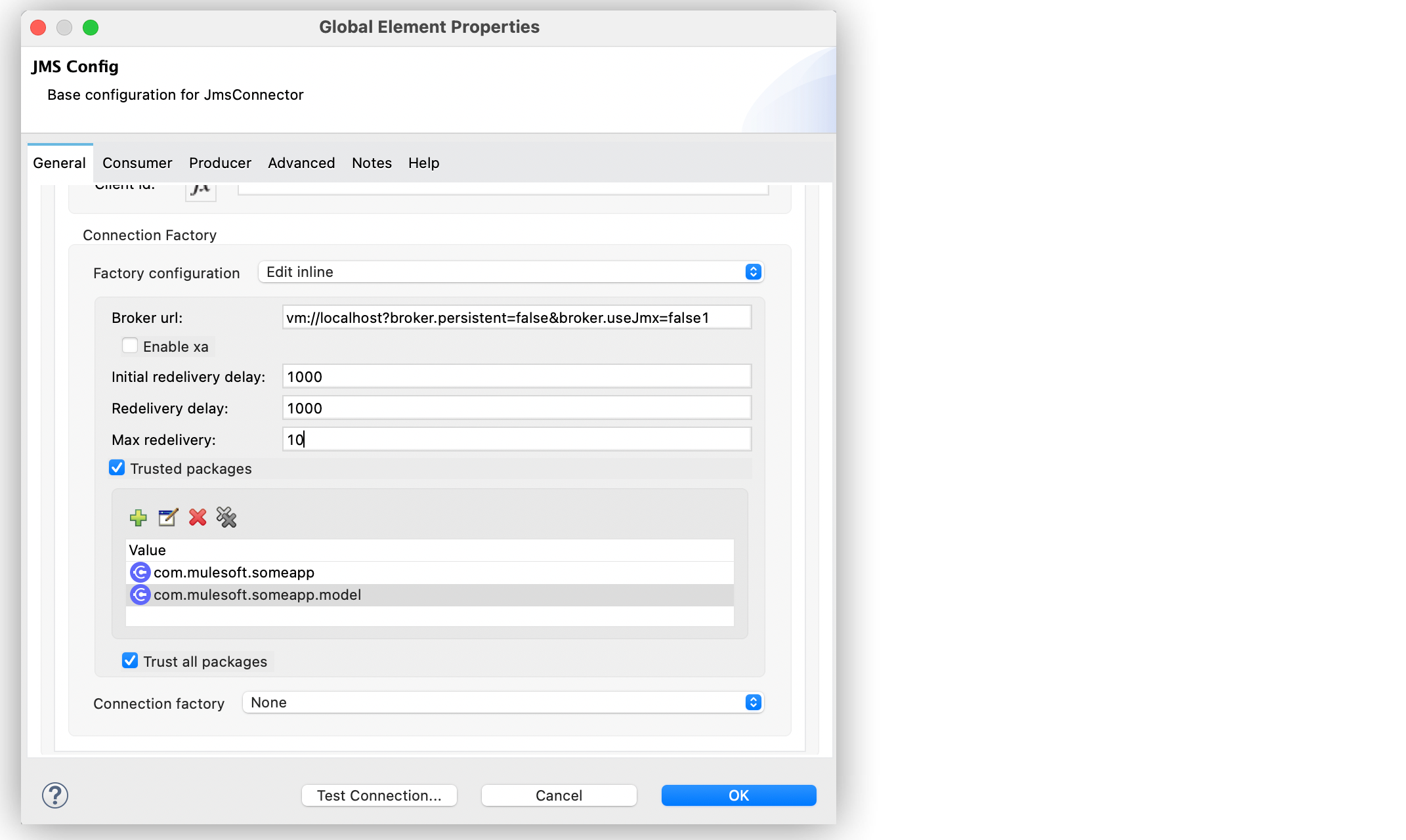
In the XML editor, the <jms:trusted-packages> and trustAllPackages configurations look like this:
<jms:config name="JMS_Config">
<jms:active-mq-connection>
<jms:factory-configuration trustAllPackages="true">
<jms:trusted-packages >
<jms:trusted-package value="com.mulesoft.someapp" />
<jms:trusted-package value="com.mulesoft.someapp.model" />
</jms:trusted-packages>
</jms:factory-configuration>
</jms:active-mq-connection>
</jms:config>Configure SSL Connections
JMS Connector version 1.3.0 and later enables you to configure ActiveMQ connections with SSL configurations to establish secure and encrypted connections against the ActiveMQ broker:
-
In Studio, navigate to the Global Elements tab.
-
Click Create.
-
In the filter box type
jmsand select JMS Config. -
Click OK.
-
In the Connection field select ActiveMQ Connection.
-
Navigate to the TLS/SSL tab.
-
In the TLS Configuration field, select Edit Inline
-
In the Trust Store Configuration section, set the following fields:
-
Path:
client.ts -
Password:
password
-
-
In the Key Store Configuration section, set the following fields:
-
Path:
client.ks -
Alias:
client -
Key Password:
password -
Password:
password
-
-
Click OK.
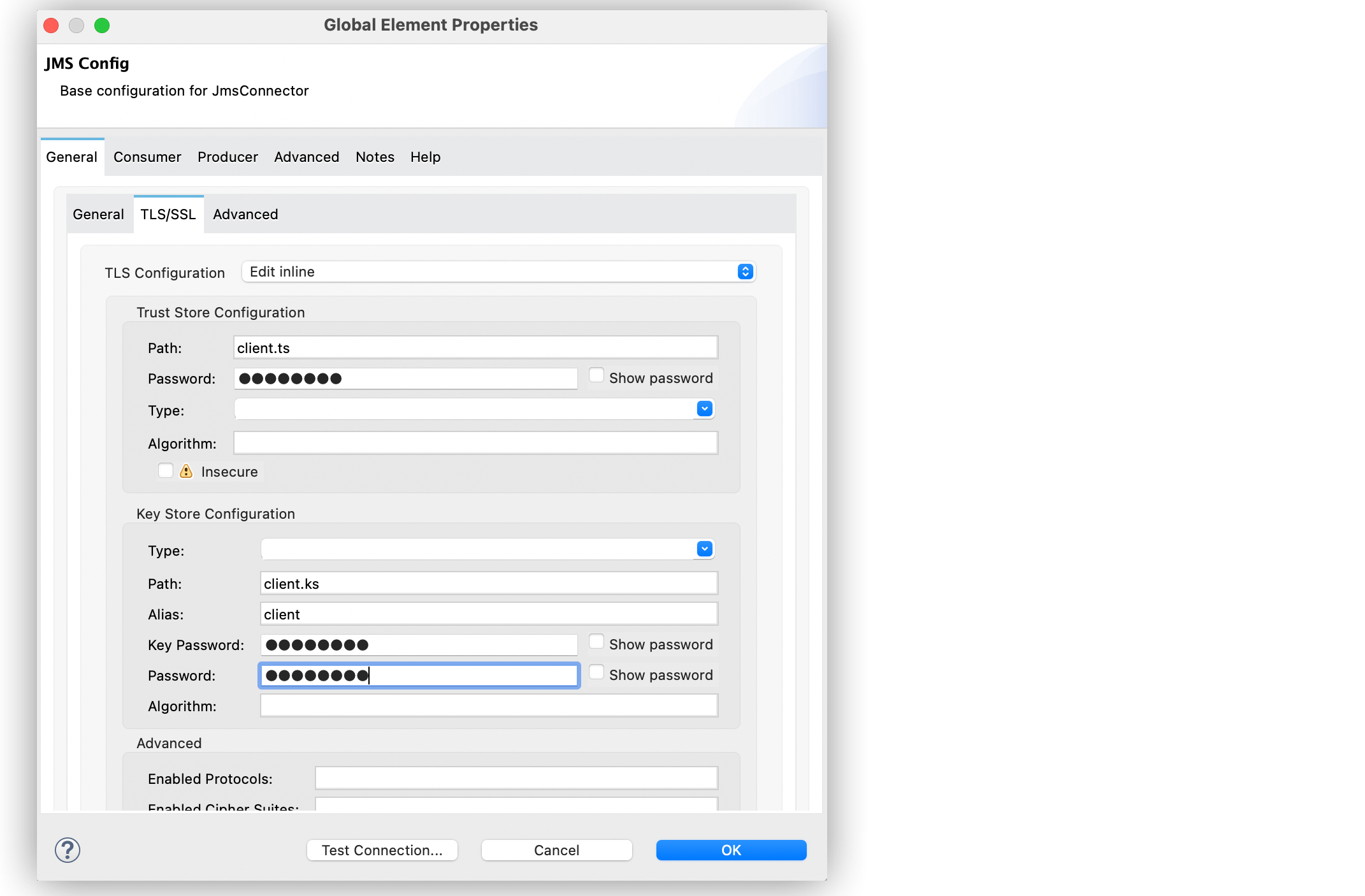
In the XML editor, the <jms:active-mq-connection>, <tls:trust-store>, and <tls:key-store> configuration looks like this:
<jms:config name="JMS_Config">
<jms:active-mq-connection>
<tls:context>
<tls:trust-store
path="client.ts"
password="password" />
<tls:key-store
path="client.ks"
password="password"
keyPassword="password"
alias="client" />
</tls:context>
</jms:active-mq-connection>
</jms:config>JMS Connector can also reference global TLS context configurations to reuse and share the same TLS context between connectors as shown in the following example with Anypoint Connector for HTTP (HTTP Connector):
<!-- HTTP Requester Configuration -->
<http:request-config name="HTTP_Request_configuration">
<http:request-connection tlsContext="TLS_Context" />
</http:request-config>
<!-- JMS Configuration -->
<jms:config name="JMS_Config">
<jms:active-mq-connection tlsContext="TLS_Context"/>
</jms:config>
<!-- Reusable TLS Context -->
<tls:context name="TLS_Context">
<tls:trust-store
path="client.ts"
password="password" />
<tls:key-store
path="client.ks"
password="password"
keyPassword="password"
alias="client" />
</tls:context>


